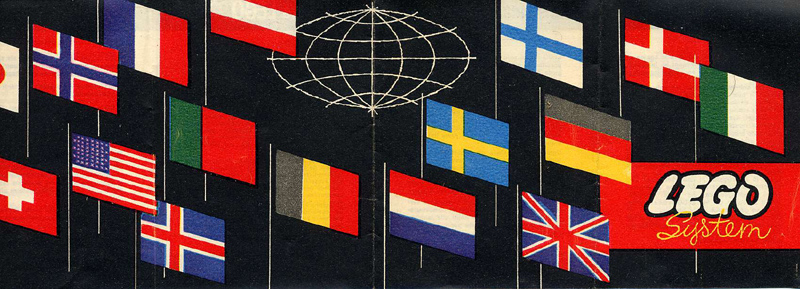
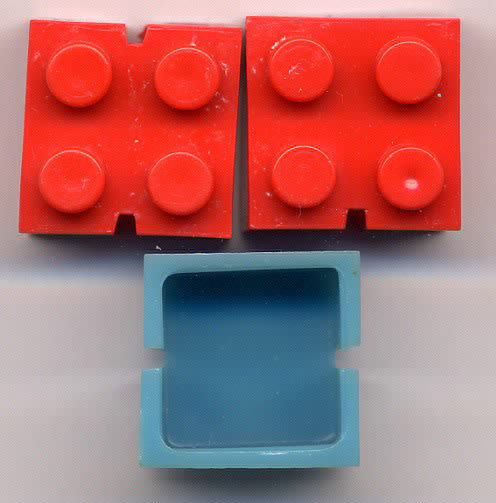
The 2X2 brick was introduced in 1949 and is one of the two original LEGO bricks. The first type (2X2vs01) is illustrated above (but see also this page on another type that may be earlier). There are no inscriptions on the bricks (logo or mold number) and thus they may be confused with unbranded products of other origins.
When seen from below, the inside corners are very rounded. This is an important distinguishing feature.
There were only mold units for two types of bricks: with a single lateral slot; and with two opposing lateral slots. The mold had at least four units: two for double slotted bricks and two for single slotted bricks. These may be told apart because the molding pip is on opposite sides of the slot.
In the first issues (from 1949 to 1951?) the bricks were molded with a distinctive catalin-type resin not used subsquently. They do not warp, are very shiny, and have a milky aspect and, as in all plastics of this type, they show considerable transparency against a soft light, even the white coloured bricks.
NOTE: In LEGO bricks the slots are molded and not cut and thus the same molding unit always produces the same type of slotted brick.
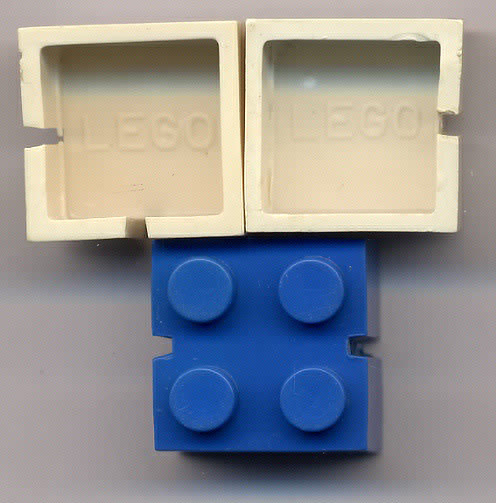
When a new mold was needed The brand name "LEGO" was carved in the mold.
Originally the logo was rather shallow and the mold units were unnumbered. Subsequently each mold unit was marked with a faint mold number inscribed by hand and the logo was deepened and made very conspicuous which suggests a clear intention to diferentiate the product from immitations.
For the first time with this mold, the three slot combinations were produced. The unit numbers of the altered mold were, according to type:
-mold nrs 1 and 2- two opposing slots;
-mold nr 3- single slot;
-mold nr 4- slots at 90º.

Circa 1954 a new mold was produced. Bricks were still slotted and mold units were made to produce all four slot combinations. The main difference is now the so-called LEGO "dogbone" logo engraved inside.
This particular subtype of 2X2vs03 is characterized by circular marks opposite each stud, made by corresponding ejector pins in the core mold. One such mark is evident on the top left corner of the far right brick in the picture above.
The molds are unumbered and have many defects, small and large (see the red brick above) resulting in a rather dull finishing, not up to the usual LEGO expectations. See also the next subtype, commoner than this one, that better characterizes the dogbone logo production of this particular brick size.
A second mold was produced at the same general time for 2X2. Bricks made with this mold are commoner and much more perfect than the type 2X2vs03a above. The differences are the high quality of this subtype (seen e.g. by the perfection of the thin dog-bone logo and by the high gloss obtained in the bricks); the absence of ejector pin marks under each stud; and the mold numbers inscribed near the logo.
Seen from above, the sides of the studs seem sometimes taller than the top- as seen in two of the studs of the green brick depicted in the image above. This is caused by the use of ejector pins on the cavity side of the mold, positioned against the stud tops.
Bricks were still slotted and mold units were made at this time to produce the opposite slotted brick (mold nrs 5 and 7) and the 90º slots (nrs 6 and 8).
NOTE: One or more molds for this type were produced later- these are numbered at the corner. The very first boxed sets sold in Germany in the Winter of 1955/56 had this kind of bricks in red and white.
The problem with the concavity of the stud surfaces on high speed injection molding, seen e.g. on the 1X2 bricks, called for thinner stud walls, and so in the first molds for non-slotted bricks produced by LEGO, the studs were hollowed.
Another feature was introduced in all the new molds: the "LEGO" logo on the studs.
Mold numbers seen: "1" to "27" and there are also unnumbered bricks. There were at least three main molds or groups of molds, of which one is numbered by hand incisions, another is machine-numbered in the center and still another is similarly numbered but off-center.
Bricks of this type were certainly sold in 1956-57 in Scandinavia and also in Germany in 1956, but were not seen in sets sold in Portugal.
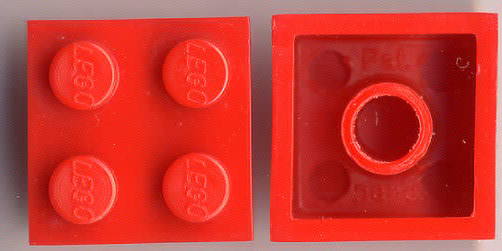
The fifth version of the 2X2 brick is easily distinguished by the underside tubes that connect firmly each brick with the brick below.
The studs are hollow with a diameter of circa 3mm, as in the previous version.
All bricks bear underside the note "Pat. pend." above and below the central tube. Mold units are identified by simple numerals set above the tube. The brick pictured is "1".
This was the first type confirmed sold in Portugal from 1957/58.
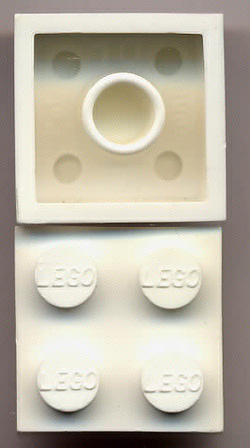
New molds were introduced circa 1960. These are distinguished by the smaller diameter hollow of the studs, correcting a possible fragility of the previous version.
Stud hollows are encircled by a ring, likely the imprint of ejector pins in the mold, faintly seen on top the adjoining brick..
The first mold or molds were identified by a number only, subsequent molds identified by a code consisting of a number and a letter on opposite sides of the underneath.